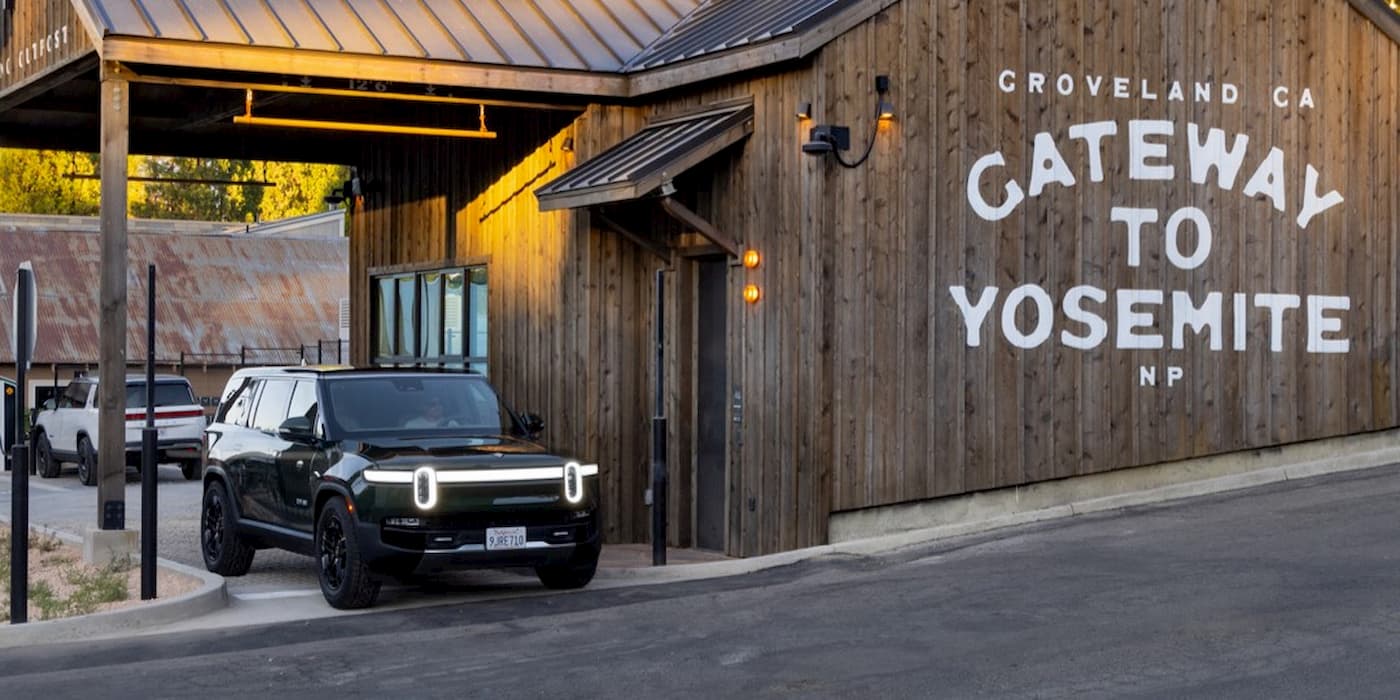
We heard a little more about Rivian’s upcoming plans to open its Rivian Adventure Network chargers at a roundtable discussion with CEO RJ Scaringe this week.
Rivian has been working on its own in-house charging network since 2020, with a focus of placing charging sites on the way to the sort of beautiful natural places that it has tied so much of its brand to.
For a primary example of this, Rivian opened its first “Charging Outpost” just outside Yosemite National Park in July, renovating an old gas station into a very cool ranger cabin-style spot to stop and refuel your car – and also yourself.
Now, it’s ready to open its network to other brands, which it announced last April. The goal was to open by the end of 2024 – which is fast approaching.
While Rivian stopped short of announcing a date for this at our roundtable discussion, it was clear that the announcement is coming “very soon.”
Scaringe told us that he was just reviewing the software that non-Rivian customers will use and that “it’s gonna be awesome.” So it sounds like there’s a plan to offer a separate app experience for non-Rivian owners, likely through the Rivian app (thus ballooning the number of apps that every EV owner needs to have… we need to do something about that).
To this end, Rivian did purchase A Better Route Planner (ABRP) last June, one of the more popular charge planning apps for EVs. This has surely been a factor in Rivian’s app development.
Scaringe told us that RAN has now expanded to a total of 91 sites and around 700 chargers – which he says is around 4% of the size of Tesla’s Supercharger network, but that RAN has maintained high uptime as it scales. Scaringe said that if you would have asked him 6-7 years ago, he would have expected more successful third-party charging companies by now., but that now, out of all the charging networks out there, there are “only two great networks – and only one great scaled network,” namely Tesla Superchargers.
The others, which aren’t owned by an EV manufacturer, just aren’t as good. RAN and Tesla have ~99% uptime, where Scaringe said that other networks have sub-70% or even sub-50% uptime (this may be an underestimate – or maybe not – but the point stands that every EV driver can tell you Tesla is the gold standard here).
So Rivian sees it as important to electrification to offer another great network that can help give drivers more choices, more availability, and high reliability.
But how will that interface with the NACS transition? Rivian was early to hop aboard and announce that it will shift to using NACS and ship adapters to its owners, though its current vehicles still have native CCS ports even post-refresh (the Korean brands will be the first to offer native NACS ports on their vehicles).
We were quite interested in the timeline of who started the discussions to shift to NACS, and Scaringe told us that it was pretty much universal across the industry that as soon as Tesla released its NACS whitepaper calling it an open standard, car companies started talking amongst themselves about the potential of finally harmonizing on a single charging standard.
As of now, Rivian is still installing CCS cables, not NACS ones. It sounded like it intends to keep doing this for the foreseeable future, and that “the charging network will catch up” as cars transition to NACS. Until then, people can use adapters – and “in the long term, everything will go to NACS” as it’s just a better standard, and whatever remaining CCS cars exist will just end up using adapters.
This seems a little strange to make cars that aren’t (natively) supported on your own charging network, but Scaringe said that that’s the benefit of owning the network – cables are not too hard to swap out. So it would be easy to just change out the cable heads on existing chargers without having to build new sites or install new cabinets.
We asked whether they’d try a dual-charging-head strategy, with NACS and CCS heads on each cabinet, but it didn’t sound like that was in the plans. The cables will, at least, be long enough to reach both sides of the vehicle – an important consideration given the lack of standardization of charging port locations on EVs, as networks start opening up to multiple brands.
So – we’re looking forward to hearing more about Rivian’s efforts to open RAN, which ought to bear fruit quite soon, if the “end of the year” schedule holds. Stay tuned, as we’re sure there’s more news to come soon.
Charge your electric vehicle at home using rooftop solar panels. Find a reliable and competitively priced solar installer near you on EnergySage, for free. They have pre-vetted installers competing for your business, ensuring high-quality solutions and 20-30% savings. It’s free, with no sales calls until you choose an installer. Compare personalized solar quotes online and receive guidance from unbiased Energy Advisers. Get started here. – ad*
